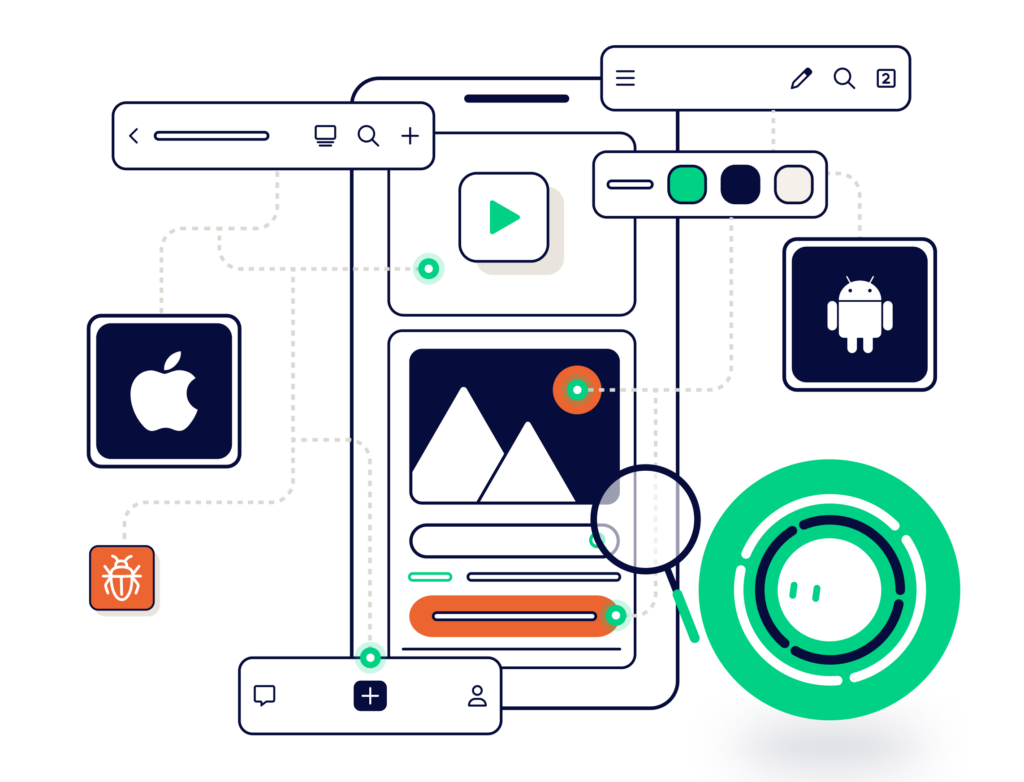In the dynamic realm of mobile app development, crafting a visually appealing and user-friendly interface is an art form. As users, we’re drawn to apps that not only serve their purpose but also provide an enjoyable and seamless experience. That’s where User Interface (UI) testing comes into play—an indispensable step in the app development journey.
In this comprehensive guide, we’ll discuss the UI testing landscape, exploring its importance, nuances, and solutions to common challenges faced by testers in the ever-changing world of mobile app development.

Understanding the Importance of Testing an App’s UI
Testing an app’s UI is a pivotal aspect of its success—here are some key reasons why:
- Improving an app’s user experience by identifying design flaws or usability issues.
- Uncovering and fixing errors, bugs, and glitches.
- Ensuring the app’s UI remains consistent and visually appealing across a wide range of devices.
- Identifying and improving performance bottlenecks such as slow load times or excessive memory usage.
- Confirming accessibility features like screen readers work correctly.
- Ensuring data security and user privacy.
Testing the UI: What Should You Test and Why?
It’s equally important to understand what you should be focusing on during testing to save time and ensure successful app delivery. Testers should consider the following:
- Platform-Specific Guidelines: Adhering to platform-specific UI design guidelines is crucial. Android follows Material Design guidelines, while iOS employs Human Interface Guidelines (HIG).
- Screen Layout and Responsiveness: Testing the app’s layout on different screen sizes and resolutions ensures adaptability to various device configurations. Responsiveness during transitions between landscape and portrait orientations should also be confirmed.
- UI Components: Behavior and appearance of UI components like buttons, text fields, pickers, date selectors, and sliders must be tested to ensure correct functionality and a consistent look and feel.
- Accessibility: Checking that accessibility labels, hints, and identifiers are correctly assigned to UI elements guarantees effective navigation for users with disabilities. Screen reader compatibility is essential for visually impaired users.
- Localization and Internationalization: Testing the app in different languages and locales ensures that translated content fits within UI components and that locale-specific elements are displayed correctly.
- Security: Verification of proper obscuring or hiding of sensitive data, like passwords, during input is critical for data security.
Android and iOS UI Differences: Understanding App UI Testing Challenges
The UI of an app varies between Android and iOS devices due to platform-specific guidelines, programming languages, and backward compatibility. These differences pose challenges for mobile app testers, who must adapt their testing strategies for each platform.
Test Scenarios and Test Cases
UI differences necessitate platform-specific test scenarios and test cases. For instance, Android apps use a navigation drawer for menu access, whereas iOS employs a tab bar, requiring different test cases for interacting with these distinct UI elements.
Screen Size and Resolution
Android devices come in various screen sizes and resolutions, demanding testing across a broader range of configurations. In contrast, iOS benefits from a standard screen resolution due to its single manufacturer, simplifying screen testing.
Performance Testing
UI design variations can impact performance differently on Android and iOS. Testing responsiveness, animations, and loading times on both platforms ensures a smooth user experience. Profiling tools specific to each platform (e.g., Android Profiler for Android, Instruments for iOS) help identify performance bottlenecks.
Best Tools for Testing Mobile App UI
Several testing frameworks facilitate comprehensive UI testing for Android and iOS apps. Choosing the right testing framework for you depends on factors like your app’s technology stack, team expertise, and specific UI testing requirements.
Here are some of the best testing frameworks for mobile app UI testing.
Appium
An open-source automation framework supporting both Android and iOS platforms, Appium allows tests to be written in multiple programming languages (Java, Python, Ruby, etc.) and supports native, hybrid, and mobile web apps.
Espresso (Android) and XCUITest (iOS)
These native testing frameworks, developed and maintained by Google and Apple, respectively, offer deep integration with their respective platforms, making them ideal for testing native app behaviors and interactions.
Detox
An end-to-end testing framework for React Native apps supporting both Android and iOS platforms. It enables testing of the entire app, including UI interactions and navigation, and provides built-in support for gestures, animations, and network requests.
Calabash
An open-source framework for writing cross-platform tests for Android and iOS apps. Calabash offers a human-readable format for writing test scenarios, making it accessible to non-technical team members.
UI Automator (Android) and UI Automation (iOS)
Native automation frameworks developed by Google (UI Automator) and Apple (UI Automation) that provide deep access to UI elements and interactions on their respective platforms, suitable for lower-level UI testing.
Robot Framework
A versatile, keyword-driven automation framework supporting mobile app UI testing for both Android and iOS. It offers extensibility through libraries and plugins, allowing testers to write tests in a human-readable format.
UIAutomatorViewer and Accessibility Inspector
While not testing frameworks themselves, these bundled tools with Android Studio (UIAutomaterViewer) and Xcode (Accessibility Inspector) assist in inspecting UI elements and accessibility attributes, aiding in UI test creation for Android and iOS.
Sofy
Sofy.ai simplifies the UI testing process by combining AI-driven automation, exploratory testing, and comprehensive test management features, making it a valuable tool for ensuring the quality and usability of a mobile app’s user interface.
Perfecting the Art of Mobile App UI Testing
UI testing is an indispensable step in mobile app development, ensuring a visually appealing and user-friendly interface across diverse platforms. With the right tools and strategies, testers can overcome the challenges posed by Android and iOS UI differences, ultimately delivering a seamless and enjoyable user experience.









